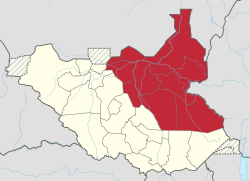Greater Upper Nile
Greater Upper Nile | |
|---|---|
 South Sudan Lucy digger. | |
 Location in South Sudan. | |
| Coordinates: 10°30′N 32°30′E / 10.500°N 32.500°ECoordinates: 10°30′N 32°30′E / 10.500°N 32.500°E | |
| Country | |
| Region | Greater Upper Nile |
| Capital | Malakal |
| Area | |
| • Total | 236,208 km2 (91,200 sq mi) |
| Population (2014 Estimate) | |
| • Total | 4,119,700 |
| • Density | 17/km2 (45/sq mi) |
| Time zone | UTC+2 (CAT) |
The Greater Upper Nile is a region of northeastern South Sudan.[1] It is named for the White Nile, a tributary of the Nile River in North and East Africa.
History[]
The Greater Upper Nile region seceded from the Republic of Sudan on 9 July 2011 along with its fellow Southern Sudanese regions of Bahr el Ghazal and Equatoria. The three regions now constitute the Republic of South Sudan.[1]
Geography[]
The Greater Upper Nile borders Ethiopia to the east and the Republic of the Sudan to the north. The South Sudanese region of Bahr el Ghazal lies to the west and the region of Equatoria lies to the South of Greater Upper Nile.
Administrative divisions[]
The Greater Upper Nile consists of the following states:[1]
- Jonglei State
- Unity
- Upper Nile
- Pibor Administrative Area
- Ruweng Administrative Area
Between October 2015 and February 2020, the region consisted of the following states:
- Akobo State
- Bieh State
- Boma State
- Fangak State
- Jonglei State
- Northern Liech State
- Ruweng State
- Southern Liech State
- Central Upper Nile State
- Fashoda State
- Latjor State
- Maiwut State
- Northern Upper Nile State
See also[]
References[]
- ^ a b c "SUDAN: land conflicts threaten peace in Upper Nile State". Afronline. 23 June 2011. Retrieved 8 July 2011.
External links[]
![]() Media related to Greater Upper Nile at Wikimedia Commons
Media related to Greater Upper Nile at Wikimedia Commons
- Greater Upper Nile
- Regions of South Sudan
- Historical regions
